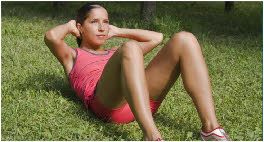Keep on Running - Win A Personal Trainer
Members of the site can win a personal training session with local trainer Richard Playfair
Easter's chocolate binge always revises many people's New Year ambitions to get fit, encouraging many first time runners to sign up for charity fun runs and descend on Putney's Parks and popular river bank runs to begin their training. Unfortunately aspirations of many are marred by injury or lack of understanding of the demands of running. So to help you on the road (or river path) to success, Putney's local Personal Trainer and Director of Playfair Fitness, Richard Playfair, gives us his tips on how to start and keep on running.
Keep a spring in your step
How old are your trainers? 1 year old? Two? Three?
If may be time to buy some new ones! Trainers should be replaced every 3-6 months depending on how often they are used. Incorrect support or cushioning whist running can lead to or exasperate injuries in the ankles, legs, knees, and back so it's important to wear appropriate footwear. The gait cycle is how your foot contacts and pushes off the floor during running and determines the type of shoe you should wear. Many Physios and specialist running shops such as Sweatshop can measure your gait and suggest appropriate footwear. There are three classifications :
Under Pronation - The outside of the heel makes initial contact with the floor. The outside edge of the foot takes the impact before pushing off through the smaller toes.
Over Pronation - The feet roll inward when hitting the ground. Common with people who are flat footed or with fallen arches. The bigger inside toes are involved in the push off phase. In some cases additional support through orthotics may be required.
Normal Pronation - Normal impact of the heel with the floor rolling evenly through the foot with an even push off from the front of the foot
Many first time runners complain of lower back pain and it's not only due to tight hamstrings or lack of flexibility. Wearing new shoes with cushioning and the right type of support can reduce the impact of running which would otherwise be transmitted through the pelvis and up the spine, leading to common back complaints.
Burn Baby Burn
Running is a great way to burn fat and the best news is the slower the better! To ensure your body is working in the most efficient fat burning zone you should run or jog at a pace that allows you to maintain a conversation. This should feel fairly comfortable allowing you to maintain the exercise for longer and burn more calories. Once your fitness improves you can add faster intervals to your sessions, to improve your speed and endurance. For example run one minute in every five a little faster, or if you listen to music while you run pick up the pace during the choruses and recover at a slower pace during the verses.
![]() Journey to the Runners Core
Journey to the Runners Core
Include resistance work in your runs and you will become a better and stronger runner, but don't just focus on your legs! Back and core strength should not be neglected - it's essential to your running posture and performance. The spine is the most flexible area of the body and needs to be supported to optimize running efficiency and to ensure energy and power from the legs isn't wasted through poor balance and lack of stability. Punctuate your runs with exercises such as squat thrusts, press ups, lunges and crunches to strengthen the key muscles groups.
Your Flexible Friend
Whenever we stress the body through exercise our working muscles contract and shorten, so to return them to pre-exercise length we have to stretch. Flexibility is a fundamental element of fitness and should not be neglected. Stretching increases blood flow to the working muscles and promotes recovery time delaying the onset of muscle soreness. Failing to stretch greatly increase your risk of injury and will make running progressively more difficult. You should spend 5-10 minutes at the end of each run stretching all the major muscle groups. Each stretch should be help at an intensity of mild discomfort (not pain) for at least 30 seconds to develop your flexibility. Pilates, Yoga and Body Balance classes are great ways to develop and monitor your flexibility.
 Be the Best - Take a Rest!
Be the Best - Take a Rest!
Exercise can be addictive, but rest is as important as training to allow your body time to adapt and recover. Set a training plan and be realistic, alternate rest and recovery days and tick off your achievements this will help you stay motivated. If you are new to running your focus should be time spent exercising and not distance covered in order to improve your endurance. Also make sure you drink plenty of water to stay hydrated this will prepare you both mentally and physically for your next run. Dehydration can lead to tiredness, poor performance lack of concentration and motivation.
March 31, 2010
Related links
|
